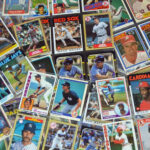The first baseball cards were sold in the 1880s. They were packaged in cigarettes as part of an advertising campaign featuring actors, war heroes, and athletes. Besides the player shown on the card, baseball cards are appraised based on many different criteria. Factors such as condition, errors, scarcity, and print type can also impact the price and value. With some exceptions, Hall of Fame cards are typically worth more than common player cards. In general, star players’ baseball cards have a premium compared to other players.
The condition of the card is based on looking at the corners, edges, centering, and surfaces for wear and tear. The edge is assessed by turning the card sideways and looking at the edge straight on. Creases, indents, marks, fading, scratches, or stains will devalue the card.
Cards are scored on a scale from 1-10, with 1 being “poor” and 10 being “almost perfect”. Generally, the older a baseball card is, the more value it will have. During printing, there are often errors. Corrected errors are when the manufacturer doesn’t notice or correct the issue. These cards tend to result in higher than usual prices. Because two versions of the card exist, collectors are willing to pay more for the uncorrected version. Different versions and print variations can affect the value along with the set sequence.

